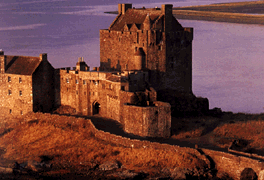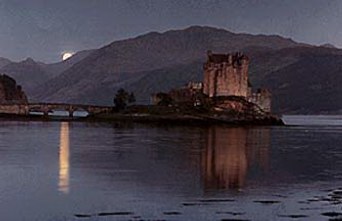Eilean Donan


EILEAN DONAN CASTLE
Eilean Donan sits on a rocky islet where three lochs meet - Loch Long, Loch Duich, and Loch Alsh. It's one of the most photographed Castles in Scotland. It has been in several movies, Most famous of them is Highlander and Highlander End Game.
Eilean Donan's beginnings can be traced back to the early 7th century. "Evidence of a Pictish fort was found in vitrified rock uncovered during excavations - some of which has been kept for visitors to see." There is also, carved in stone an impression of a human foot, these have been found through out Scotland at the entrances of Iron Age settlements.
Eilean Donan is Gaelic for "Island of Donan" referring to St. Donan. In 580 AD, Abbot Donan a missionary, whose work was spreading Christianity to the pagans, is thought to have lived on the islet as a religious hermit.
Churches bearing Abbot Donanís name can be found in Loch Carron, Loch Broom, Kildonan in Skye and at Eilean Donan, where a small oratory or cell once stood. On Sunday April 17, 618 AD, his monastery on Eigg was raided by robbers. Abbot Donan asked they not kill him unit he had finished saying mass. They granted him his request, and Abbot Donan along with 52 of his monks were beheaded afterwards.
Eilean Donan Castle was built in c.1260, commissioned by King Alexander II (1214-1250), to protect his subjects from the Norwegians. As a reward for his services during the battle of Largs, Alexander III, gave Eilean Donan Castle to Colin Fitzgerald, son of the Earl of Desmond and Kildare (latter to become Mackenzies), in 1263.
John Mackenzie, Second Earl of Kintail, gave refuge to Robert the Bruce in Eilean Donan Castle. After defeating his enemies in 1331, Robert the Bruce took his position as King of Scotland. He appointed his nephew, Randolph, Earl of Moray and Warden of Scotland. Not much respect for the law was being shown in this region. Upon his arrival Randolph had fifty local men beheaded and hung their heads from the battlements of Eilean Donan Castle, as a grim warning to others.
"During the 14th century, Eilean Donan was the subject of a dispute between the Mackenzies and the Earldom of Ross. The Earldom laid claim to the castle and threatened to back the claim with force. However a charter of David II, in 1362 confirmed the Mackenzies possession. By this time, MacLennans and MacRaes settled in the district, the latter quickly rising to the position of defenders and protectors of the Mackenzies."
In 1427, the Countess of Ross was in need of a third husband. She fancied handsome young Alexander Mackenzie. When Alexander turned down her marriage proposal she had him immediately thrown into the dungeon. She took his signet ring hoping to lure Duncan MacAuley, Constable of Eilean Donan, to Dingwall in hopes of gaining possession of the castle. Duncan was suspicious and discovered Alexander was being held prisoner. He seized her kinsman Walter Ross for an exchange. By fooling the Countessís garrison (that was in Eilean Donan) Duncan and his men got inside the castle and once inside threw the Countessís men out. The Countess released the young Chief and subsequently retired to the Abbey of Elcho.
The Mackenzies became barons of Kintail. The clan MacRae became the bodyguard of the Chief of Kintail, and became known as the "Mackenzies Coat of Mail". In 1509, the MacRae clan were appointed Constables of the castle. A stronghold, the castle was never captured by an enemy, during the early violent years of Scotland. Many unsuccessful raids were made by the Clan MacDonald, during which a MacRae arrow shot from the castle, killed Donald Gorm in 1537, the last MacDonald to claim the title of Laird of the Isles.
In 1715, the Clan MacRae gathered at the castle where the warriors danced on the Well Tower roof before going off to the battle of Sherrifmuir, from which very few returned.
In 1719, Mackenzie (now the Earl of Seaforth) supported the Spanish King. The castle was garrisoned with Spanish troops, their gunpowder stored in the castleís dungeon. Three English warships sailed into Loch Duich and after a short siege, they captured the Spanish soldiers who were imprisoned at Leith.
The Castle is haunted by the ghost of one of the Spanish soldiers who was killed during the siege.
It is unclear how the castle actually was destroyed. One account tells that Colonel Donald Murchison and Christopher MacRae feared losing possession of the castle to the English and having their soldiers occupy it. They decided it would be safer to render the castle useless, and lit a match to the powder magazine. Another theory is that the troops from one of the ships discovered the gun powder and damaged enough of the castle to render it useless. Iíve also read that the castle was destroyed by cannon fire from the three ships in the Loch.
No matter how it was destroyed, the castle lay in ruin for 200 years. In 1912, Lt. Colonel John MacRae bought the castle with plans to rebuild and once again be the gathering place for the MacRaes. "He found a local man, Farquhar MacRae of Auchtertyre, eager to lead the rebuilding effort. They wished to build an authentic reconstruction but no plans or drawings of the original castle could be found. Farquhar took action typical of a highland Scot...he went home to pray and ask the Lordís help. He was amply rewarded when a vision of the castle did, indeed, come to him in a dream! The vision was committed to working plans and construction began. In 1934 the castle was finally opened for public viewing. The masterpiece was a sensation and other historic researchers were able to locate ancient sketches of the castle and validate Farquharís dream!"
Today Eilean Donan Castle proudly stands as the seat of the Clan MacRae.

